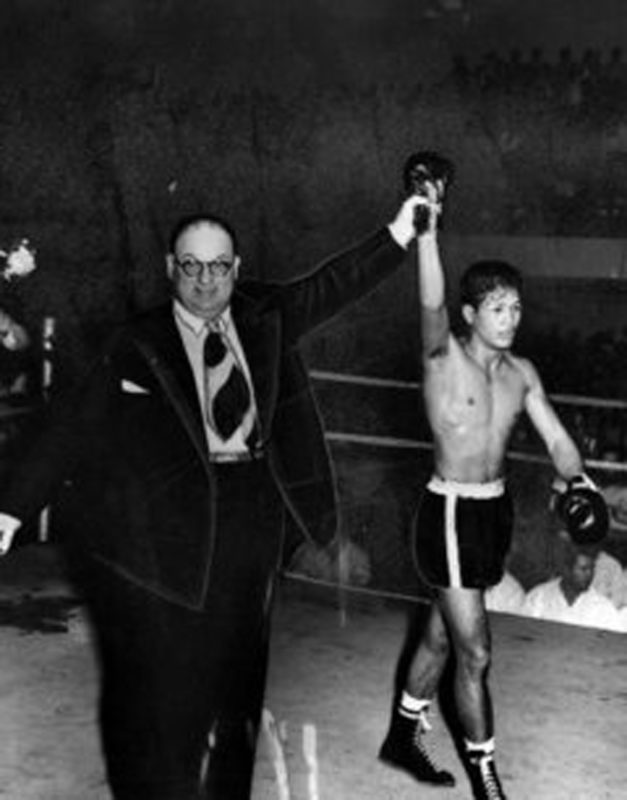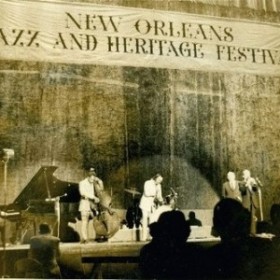The Municipal Auditorium was built in 1930, as a host to different types of entertainment making their way to New Orleans. Because the venue was very large, many diverse performers were able to showcase their talents. The seating capacity of the Auditorium section could hold 4625 people. Also included was a Concert Hall and two other Assembly Halls, making the seating capacity of the entire auditorium 10,600. The Municipal Auditorium was the largest hall, venue, or auditorium in New Orleans at that time.
The Municipal Auditorium took 2 million dollars to create. Many people even thought that its stance was going to revolutionize New Orleans. It faced the historic Beauregard Square and was located at 1201 St. Peters Street. Because of its prime location and grandeur presence, it was referred to as “One of the Show Places of the World” (Times Picayune).
Affairs

Announcer Duke Durel, claims Bernie Docousen the victor after his TKO victory over Tippy Larkin. The Municipal Auditorium contained some 7570 fight fans and the promoters collected a net of $18,317. Photo courtesy of Jim Rasch.
It was the center of the Grand Opera of the South. Because of it’s size, the possibilities were endless. It held carnivals, balls, Sugar Bowl sporting events, industrial shows, trade exhibits, the New Orleans Symphony Orchestra, the Philharmonic Orchestra, road shows, musical comedies, lectures, conventions, the roller derby, professional boxing, and many others. It hosted the Broadway Theatre League of New Orleans, including shows such as Fiddler on the Roof, along with many other Broadway shows. In addition, the auditorium hosted a dance review and brought along with it a school of dancing for those who were interested in learning (LA Collections)
Atmosphere
The manager’s name was Irwin Poche. He was always looking to improve the auditorium in any way possible. He added air conditioning, a huge advancement, since the auditorium was always packed with temperatures outside reaching uncomfortably high. He also planned to remove a swimming pool across the street and replace it with an ice skating rink, but never followed through. The manager was very ambitious to keep this a prime place of entertainment and to continually attract more and more residents of New Orleans to the Municipal Auditorium (LA Collections).
Patrons
The playbill listing the events for the Municipal Auditorium had written on the front “United We Stand” in red, white, and blue. The owner, manager, and civilians had very strong patriotism. It was also well known for its professional enthusiasm. It was enjoyed by professors and universities in New Orleans. Municipal Auditorium even held the inauguration of Herbert Eugene Longnecker, President to Tulane. Admirers of drama and entertainment found pleasure in the Municipal Auditorium as well. It attracted a large number of wealthy patrons because it offered many favorable circumstances. It continued to grow for a long period of time (Special Collections Vertical Files).
Music

New Orleans Jazz and Heritage Festival. Photo courtesy of Jim Rasch.
Built in 1930 for $2.5 million, the Municipal Auditorium was intended as a memorial to World War I veterans, but morphed into a southern hub for musicians. It sits on the original site of officially sanctioned gatherings of slaves in Congo Square. At these gatherings, African and African-rooted dancing, singing, and drumming provided entertainment. Soon after its construction, the auditorium’s elegant gathering spaces became a center of civic life in New Orleans. Over the years, the building has welcomed auto shows, hockey games, conventions, in addition to many musical acts. The auditorium hosted the music festival that grew into the New Orleans Jazz and Heritage Festival. Additionally, it was a one time home of the New Orleans opera and symphony and has hosted other concert performances by musical greats such as The Beatles and Elvis Presley (Souther, Mark J., Louisiana History: The Journal of the Louisiana Historical Association).






